Metabolomic Diversity
Researchers also screened participants’ fecal samples with 165 rRNA gene sequencing. Although their microbiome diversity did not change much over two weeks, there was an early trend toward a more diverse metabolome after the diet intervention, said Dr. Guma.
Patients with better clinical responses, such as dramatic drops in pain scores, had a more diverse fecal microbiome at baseline compared to those with less symptomatic improvement. Metabolomic diversity was similar across all participants at baseline, but afterward, those with greater clinical responses at day 14 had more diversity of metabolites than those with milder responses. What made the difference?
The researchers concluded that strict diet adherence or having a healthier diet at baseline, with higher consumption of such foods as whole grains, fish or enzymatic fruits seemed to correlate with greater improvements in symptoms, such as pain.
Next, Dr. Guma and her laboratory team would like to compare outcomes of RA patients on the ITIS diet to the Mediterranean diet, or to follow patients on longer-duration dietary interventions to see if it may have a positive effect on their microbiome.
“With a longer diet, you may be able to really change the gut microbes to slowly achieve a better microbiome,” she said. “We want to see if that, together with the right pool of metabolites, would mean a better response.”
Susan Bernstein is a freelance journalist based in Atlanta.
References
- Spector T, Asnicar F, Berry S, et al. Microbiome signatures of nutrients, foods and dietary patterns: Potential for personalized nutrition from the PREDICT 1 study. Curr Dev Nutr. 2020 Jun;4(suppl 2):1587.
- Li J, Li Y, Ivey K, et al. Interplay between diet and gut microbiota, and circulating levels of trimethylamine N-oxide: Findings from the men’s lifestyle validation study [abstract P507]. Circulation. 2020 Mar 2;141(suppl 1):AP507.
- Bustamante MF, Augustin-Perez M, Cedola F, et al. Design of an anti-inflammatory diet (ITIS diet) for patients with rheumatoid arthritis. Contemp Clin Trials Commun. 2020 Jan 21;17:100524.
- Skoldstam L, Hagfors L, Johansson G. An experimental study of Mediterranean diet intervention for patients with rheumatoid arthritis. Ann Rheum Dis. 2003 Mar; 62(3):208–214.
- Kjeldsen-Kragh J, Haugen M, Borchgrevink CF, et al. Controlled trial of fasting and one year vegetarian diet in rheumatoid arthritis. Lancet. 12 Oct 1991;338(8772):899–902.



